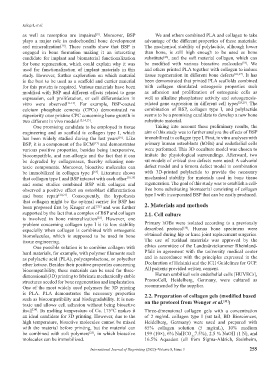Page 263 - IJB-8-3
P. 263
Kriegel, et al.
as well as resorption are impaired . Moreover, BSP We and others combined PLA and collagen to take
[9]
plays a major role in endochondral bone development advantage of the different properties of these materials:
and mineralization . These results show that BSP is The mechanical stability of polylactide, although lower
[10]
engaged in bone formation making it an interesting than bone, is still high enough to be used as bone
candidate for implant and biomaterial functionalization substitute , and the soft material collagen, which can
[26]
for bone regeneration, which could explain why it was be modified with various bioactive molecules . We
[18]
used for functionalization of implant materials in this and others printed PLA together with collagen to induce
study. However, further exploration on which material tissue regeneration in different bone defects [26,27] . It has
is the best to be used as a scaffold and carrier material been demonstrated that printed PLA scaffolds combined
for this protein is required. Various materials have been with collagen stimulated osteogenic properties such
modified with BSP and different effects related to gene as adhesion and proliferation of osteogenic cells as
expression, cell proliferation, or cell differentiation in well as alkaline phosphatase activity and osteogenesis-
vitro were observed [11-13] . For example, BSP-coated related gene expression in different cell types [28,29] . The
calcium phosphate cements (CPCs) demonstrated no combination of BSP, collagen type I, and polylactide
superiority over pristine CPC concerning bone growth in seems to be a promising candidate to develop a new bone
two different in vivo models [12,14,15] . substitute material.
One promising candidate to be employed in tissue Taking into account these preliminary results, the
engineering and as scaffold is collagen type I, which aim of this study was to further analyze the effects of BSP
has been widely studied during the last years . Like immobilized in collagen type I. First, in vitro analyses with
[16]
BSP, it is a component of the ECM and demonstrates primary human osteoblasts (hOBs) and endothelial cells
[17]
various positive properties, besides being inexpensive, were performed. This 3D coculture model was chosen to
biocompatible, and non-allergic and the fact that it can imitate the physiological surroundings. Afterward, two
be degraded by collagenases, thereby releasing non- rat models of critical size defects were used: A calvarial
toxic components. Moreover, bioactive molecules can defect model and a femora defect model in combination
be immobilized in collagen type I . Literature shows with 3D-printed polylactide to provide the necessary
[18]
that collagen type I and BSP interact with each other [18,19] mechanical stability for materials used in bone tissue
and some studies combined BSP with collagen and regeneration. The goal of this study was to establish a cell-
observed a positive effect on osteoblast differentiation free bone substituting biomaterial consisting of collagen
and bone repair [20,21] . Consequently, the hypothesis type I with incorporated BSP that can be easily produced.
that collagen might be the optimal carrier for BSP has 2. Materials and methods
been proposed first by Kruger et al. and was further
[22]
supported by the fact that a complex of BSP and collagen 2.1. Cell culture
is involved in bone mineralization . However, one
[23]
problem concerning collagen type I is its low stability Primary hOBs were isolated according to a previously
[30]
especially when collagen is combined with osteogenic described protocol . Human bone specimens were
biomolecules, which is supposed to be used in bone obtained during hip or knee joint replacement surgeries.
tissue engineering. The use of residual materials was approved by the
One possible solution is to combine collagen with ethics committee of the Landesärztekammer Rheinland-
hard materials, for example, with polymer filaments such Pfalz in agreement with the university medical center
as polylactic acid (PLA), polycaprolactone, or polyether and in accordance with the principles expressed in the
ether ketone. Besides their positive properties concerning Declaration of Helsinki and the ICH Guidelines for GCP.
biocompatibility, these materials can be used for three- All patients provided written consent.
dimensional (3D) printing to fabricate mechanically stable Human umbilical vein endothelial cells [HUVECs],
structures needed for bone regeneration and implantation. PromoCell, Heidelberg, Germany, were cultured as
One of the most widely used polymers for 3D printing recommended by the supplier.
is PLA. PLA demonstrates the necessary properties 2.2. Preparation of collagen gels (modified based
such as biocompatibility and biodegradability. It is non- on the protocol from Wenger et al. )
[31]
toxic and allows cell adhesion without being bioactive
itself . Its melting temperature of Ca. 175°C makes it Three-dimensional collagen gels with a concentration
[24]
an ideal candidate for 3D printing. However, due to the of 2 mg/mL collagen type I (rat tail, BD Biosciences,
high temperature, bioactive molecules cannot be mixed Heidelberg, Germany) were used and prepared with
with the material before printing, but the material can 65% collagen solution (5 mg/mL), 10% medium
be combined with soft polymers , in which bioactive 199 (10×), 6% NaHCO 7.5%), 2.5 % NaOH (1 N), and
[25]
3 (
molecules can be immobilized. 16.5% Aquadest (all from Sigma-Aldrich, Steinheim,
International Journal of Bioprinting (2022)–Volume 8, Issue 3 255

